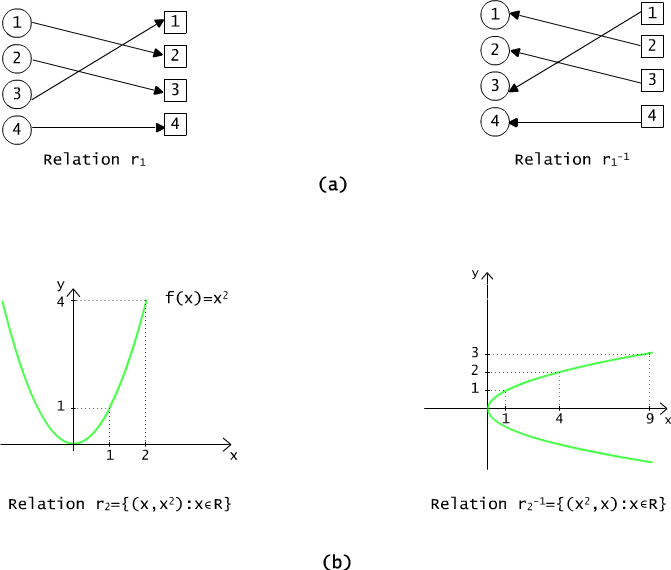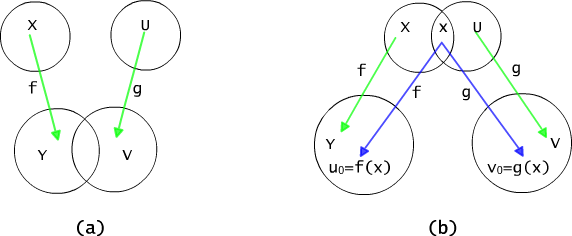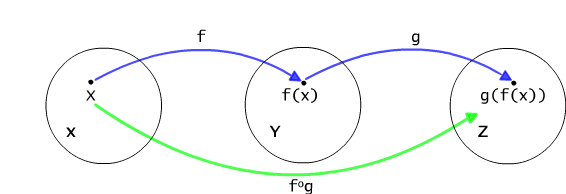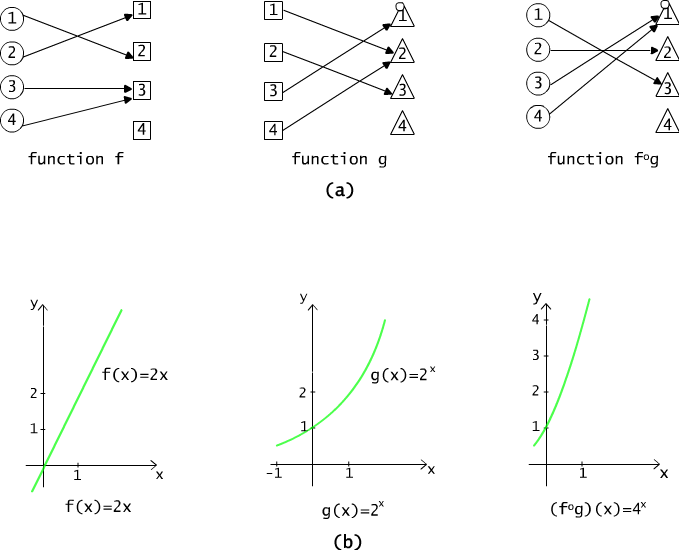
| « previous sectiont | next section » |
Functions are special types of relations, so the operations defined on relations can also be applied to functions. Unfortunately not all of them lead from functions to a function.
Let us consider the set-theoretic sum of two functions f and g, f: X → Y and g: U → V.
f ∪ g = { (x,y) : y = f(x) } ∪ {(u,v) : v = g(u)}
If only the sets X and U are disjoint then the sum f ∪
g is a function, beceuse there is no two pairs who would have the same
predecessors and successors. Hence, the sum f ∪
g determines a function h defined conditionally as:
In an opposite case, when X ∩ U ≠ ∅, the sum f ∪ g does not have to be a function, cf. Fig. 3.3.1. If x ∈ X and x ∈ U, but f(x) ≠ g(x), then both pairs (x,f(x)) i (x,g(x)) belong to the set f ∪ g, and therefore it is not a function.

Fig. 3.3.1 The sum of functions can, but doesn't have to be a function.
In the case of intersection of two functions, f ∩ g, the problem is much easier:
f ∩ g = { (x,y) : y = f(x)} ∩ {(u,v) : v = g(u)},
hence it is a mapping from X ∩ U into Y ∩ V.
Question 3.3.1 The given function f : X → X is total. When the complement of the set {(x,f(x))}x ∈ X , i.e. (X × X)/ {(x,f(x))}x ∈ X, is a function?
Let's assume that, our choice of functions is limited to the ones having the real values, so we consider only the functions f : X → R (the set X does not neccessarily has to be a set of numbers). On such functions we can execute arithmetical operations. Let f1 : X → R and f2 : X → R, then one can create the new functions f, g, h in a following manner:
f(x) = f1(x) + f2(x),
g(x) = f1(x) * f2(x),
h(x) = f1(x) / f2(x).
Please note, that the functions f and g are defined for all x, for which also the functions f1 and f2 are defined (that is for x ∈ Dom(f1) ∩ Dom(f2) ). The function h is defined only for x ∈ Dom(f1) ∩ Dom(f2) ∩ {x : f2 (x) ≠ 0}.
Question 3.3.2 Will the sum of any two one-to-one functions f1 : R → R i f2 : R → R, defiened by the formulae (f1 + f2 )(x) = f1(x) + f2(x), be a one-to-one function?
----- Check the Answer -----Now, we will disscuss the operations of composition and of inversion. The question then becomes whether the compositon of two functions is a function and whether the inversion of a function is a function as well. Let f: X → Y and g: Y → V. According to the definition 2.4.2, f ° g is a binary relation defined in a product X × V. If for some different elements v' and v" of the set V,
(x,v') ∈ f ° g, (x,v") ∈ f ° g
then there would be the elements y' and y" in Y, such that
x f y' and y' g v' also x f y" and y" g v".
Since f is a function, then it must be y ' = y". In this case
however we have y' g v' and y' g v", what contradicts the assumption
that g is also a function. From this argumentation we can
conclude that as long as relations taking part in the operation are
functions, thier composition is a function as well (por. Fig.
3.3.2). This leads us to the following definition 3.3.1.

Fig. 3.3.2 Composing functions.
Definition 3.3.1
Let f: X → Y and g: Y → V are fuctions. By composition of f and g we understand a function f ° g : X → V, determined by a formulae
(f ° g)(x) = g(f(x)) for each x such that, x ∈ Dom(f) and f(x) ∈ Dom(g).
The obvious conclusion of the above is that the composition of total functions is also a total function.
Figure 3.3.3 pictures the exmples of functions and their
compositions.
The composition of function f(x) = x2 +1 with the function
g(x) = x+5, defined in the set of real numbers, is
function h : R → R
such that,
h(x) = (f ° g)(x) = g(f(x)) = g(x2 +1) = (x2 +1) + 5 = x2 +6.
The composition of function g(x) = x+5 with the function f(x) = x2 + 1, is function h' : R → R such that
h'(x) = (g ° f)(x) = f(g(x)) = f(x +5) = ((x+5)2 +1) = x2 +10x +26

Fig. 3.3.3 Examples of functions and their compositions.
Let's note the observation following from the examples above:
Lemma 3.3.1
The equation of the point (2) should be understood in a way that the left part of the equation is defined if and only if, the right side is defined, and if both sides have defined values, then they are equal.
The proof of the above point (1) ensues directly from the
example
discussed above. For the proof of the point (2) let us notice that
assuming that all functions appearing in the equalities below are
defined on x, we have
f ° (g ° h)(x) = (g ° h) (f(x)) = h(g(f(x))) = h((f ° g )(x)). = ((f ° g ) ° h)(x).
Question 3.3.3 Is the composition of two permutations a permutation ?
Lemma 3.3.2
Let f: X → Y and g: Y → Z.
Proof.
Ad. (1) Let f and g be a one-to-one functions and let x1 ≠ x2 . Since f was assumed to be a 1-1 function then f(x1) ≠ f(x2). Similarly, function g was also assumed to be a 1-1 mapping, so g(f(x1)) ≠ g(f(x2)), hence g(f(x1)) ≠ g( f(x2)), that is (f ° g) is a one-to-one function
Ad. (2) Let us take the arbitrary element z0 ∈ Z. We want to show that for this elemet there is an argument x0 such that (f ° g)(x0) = z0. Indeed, if g is mapping on Z, then there is an element y0 in set Y which in transformed in z0. Similarly function f, as a mapping on the set Y has such element x0 that f(x0) = y0 . Finally (f ° g)(x0) = g(y0 )= z0.
Definition 3.3.2
Function g: Y → X is called an inverse of f : X → Y, if Dom(g) = Im(f) and Dom(f) = Im(G) also g(f(x))= x for every x ∈ Dom(f).

Fig. 3.3.4 The result of inversion does not have to be a function.
Example 3.3.1
(1) Figure 3.3.4 shows two relations r1 and r2 and their inverses r1-1, r2-1. Let us notice that in the first case both relations r1 and r1-1 are functions. In the second case, even though the relation r2 is a function, its inverse r2-1 is not a function, becase both pairs (4,2) and (4, -2) belong to r2-1. What makes such a difference? Namely, the relation r1 is a one-to-one function and the relation r2 is not.
(2) Let's consider one more function f : N → NP, f(n) = 2n+1 which maps the set of natural numbers on set of odd numbers NP. Function g : NP → N determined with a formuleae g(n) = (n-1) div 2 for n ∈ N, is an inverse to f. In fact, g(f(n)) = g(2n+1) = (2n+1 -1) div 2 = 2n div 2 = n.
(3) Exponential function f(x) = 2x has an inverse called a two based logarithm, denoted usually by lg, lg : R+ → R ,
lg x = a iff 2 a = x.
The inverse of a given one-to-one function f is marked just like the inverse relation f -1.
Note For every 1-1 function mapping X on Y there is exactly one inverse function. The inverse of the given 1-1 function is also a 1-1 function.
Question 3.3.4 Let ~ be a relation in a set of all functions from the set X on X such that f ∼ g wttw f is the inverse of g. Is that a symetrical relation?
Lemma 3.3.3
For any functions f : X → Y and g : Y → Z, if f and g are bijections there are functions (f ° g) -1 : Z → X, g -1 : Z → Y, f -1 : Y → X and also the following equality is true (f ° g) -1 = g -1 ° f -1.
Proof.
According to the assumption and the lemma 3.3.2, the composition (f ° g) is a 1-1 function mapping X on Z. Therefore there is an inverse (f ° g) -1, which maps Z on X. For any z ∈ Z and x ∈ X we have
(f ° g) -1(z) = x iff (f ° g)(x) = z iff g(f(x)) = z iff there is an y such that y = f(x) i g(y) = z iff there is an y such that f -1 (y) = x also g-1 (z) =y iff f -1 (g-1(z)) = x iff (g -1 ° f -1)(z) = x.
| « previous section | next section » |